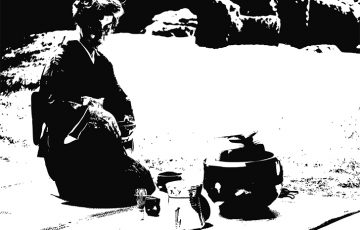In the north of the country and in the mountains it still feels like winter: the snow-whitened peaks are clear against the blue sky and the nights cold enough to see your breath on the dark air. Along the coast and to the south the plum trees are blooming or have bloomed, but up here the first sign of spring – other than the green buds of butterbur poking through the snow – is the Hinamatsuri.
Anyone with a passing acquaintance with Japan, let alone those who have been in the country in late February and early March when the hina dolls are displayed, will be familiar with the festival. You see them in shop windows and in restaurants, occasionally in the display cases at train stations, and always in houses with daughters. This is, at its heart, a girls’ festival, and is sometimes known in English as Girl’s Day, though it translates more literally as the Doll’s Festival. The dolls are dressed in formal wear that dates back to the Heian era (794 to 1185), and it would be easy to think that this festival has been handed down unchanged, from mother to daughter, for a thousand years.
History is seldom so simple. The Hinamasturi has roots that reach far further back – and further away – than the Heian period which gave the hina dolls their name as well as their twelve layered kimono.
Celebrated on the third day of the third month, the Hinamatsuri, like the other monthly festivals (the festival of the seven herbs, children’s day, Tanabata, and the double ninth festival) originated in China. Chinese numerology considered many of these usually double-number dates to be unlucky, and required offerings and sacrifices to be made in order to avert evil. On the third day of the third lunisolar month – when the peach trees are in bloom in China – it was customary to perform a purification, though even by Confucius’s time these elaborate bathing ceremonies were falling out of use. The festival continued to hold its significance, though, and shooting parties often marked the date, and hanami parties gathered below the blossoming peaches.
How and when the festival, then called Joshi, made its way to Japan is lost, as is so often the case, in the mists of time. Murasaki Shikibu describes the already firmly established rite in her Heian period novel the Tale of Genji, in which, on the third day of the third month a little boat containing dolls was set adrift on the ocean, taking bad luck and the evil spirits responsible out to a watery grave. Though the festival, in its modern form, has changed completely through much of the country, in Kyoto paper dolls are still floated downstream on the waters of the Kamo River.
Though the modern name of the festival, Hinamatsuri, also comes from the Heian era, when it was popular for little girls at court to play with hina dolls, it wasn’t until the Muromachi period that the dolls began to be displayed on the third day of the third month. By the Edo period the Hinamatsuri had begun to take on its present form. An increasingly wealthy merchant class started displaying court-style dolls on the Joshi day, in hopes of ridding their daughters of the possible bad fortune brought by evil spirits. As the craftsmanship (and price) of the dolls increased, people became unwilling to send their dolls downstream or out to sea as scapegoats. Instead, it became customary to take the dolls to a shrine or temple where they were relieved of bad spirits by prayer, and eventually returned to the house. By the time the calendar changed during the Meiji era, putting March 3rd out of sync with the associated peach blossoms, hina dolls were being displayed on tiered pedestals.
Today, dolls are seldom taken from the house, but they retain their association with prayers for the health of girls. Pedestals now often reach seven steps in height and contain dolls representing the emperor, empress, ministers of right and left, three court ladies, five court musicians, and three samurai or protectors. Each figure is displayed with associated accessories, and all wear the traditional court dress of the Heian period. Lower steps display courtly furniture, carriages and tools. Two trees – a flowering cherry and a fruit bearing mandarin orange tree – complete the set, and there are vases of silk peach blossoms keep the festival’s connection to the old months and their seasons.
Story and photo by Skye Hohmann
From J SELECT Magazine, March 2010















Recent Comments